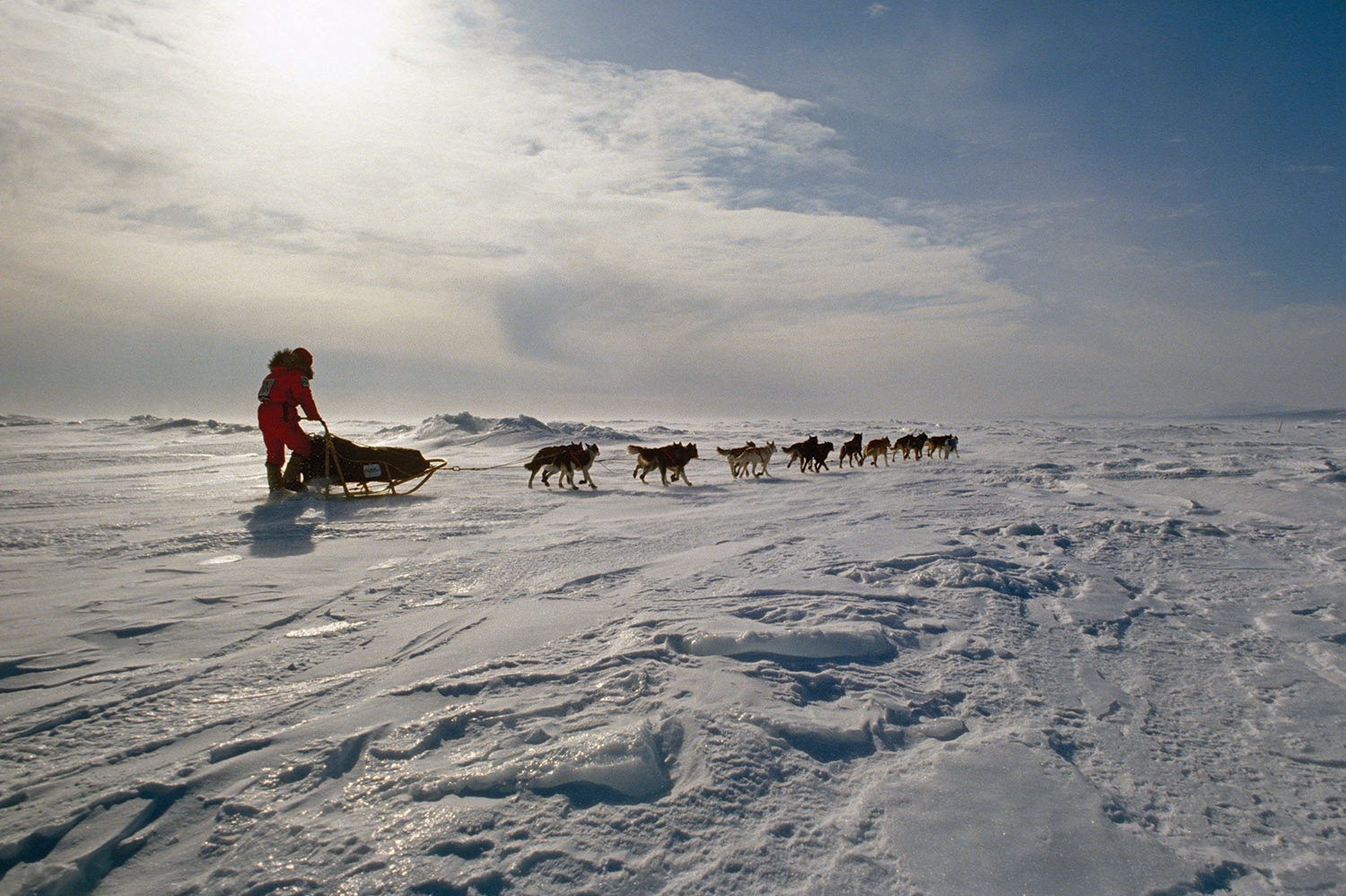IN 1985, SUSAN BUTCHER was a favorite to win the Iditarod, the grueling 1,000-mile-plus dog-sled race across Alaska’s empty interior that some consider the toughest athletic event on the planet. Over the previous five years, Butcher had enjoyed a meteoric rise from total unknown to top contender, including second-place finishes in the Iditarod in 1982 and 1984.
Although a few women had completed the race in prior years, none besides Butcher had come even close to finishing among the top contenders. Many thought the race was too brutal to be won by a woman—a typical Iditarod at that time took close to two weeks to finish, during which time a musher might sleep for a total of 24 hours, all the while braving 100-mile-per-hour winds, blizzards with whiteout conditions and potentially deadly thin ice.
On the surface, Butcher seemed an unlikely person to shatter the Iditarod’s glass ceiling. Just 5 feet 6 inches and of average build, she was hardly physically imposing. Moreover, she wasn’t a native Alaskan. Born Dec. 26, 1954, she grew up in Cambridge, Massachusetts.
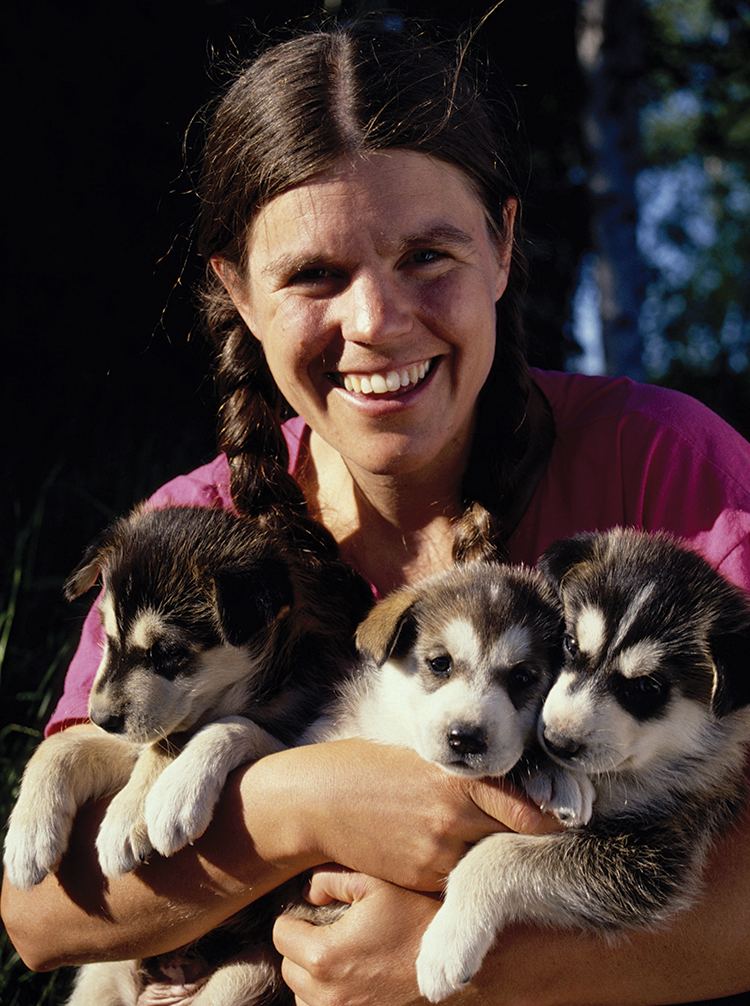
Butcher raised and trained dogs year-round at her home in Eureka, Alaska. Photo by Jeff Schultz / AlaskaStock.com
Butcher knew at an early age that she wanted to escape to the wild. She moved to Denver when she was 17 and learned the essentials of mushing from a woman who raced dogs there. She also took veterinary technician classes at Colorado State University in Fort Collins, but had no interest in sitting in a classroom, instead preferring the outdoors.
Her family was skeptical when she decided to relocate to the remote Alaskan wilderness to raise and race dogs professionally. But Butcher was nothing if not determined. When, in 1975, the 20-year-old moved to the Wrangell-St. Elias Range, 50 miles away from the closest road, she felt she was exactly where she wanted to be.
“She loved the outdoors. She loved the dogs. She loved the adventure and the solitude,” says David Monson, a successful musher who met Butcher in 1980, a year after she became the first person to lead a dog sled to the top of Mount McKinley. The couple married in 1985 and lived in a one-room cabin in Eureka, Alaska, where they ran a kennel and trained hundreds of dogs. “She was very competitive and focused on her dogs—that’s what really made her different.”
Butcher was well-known for her close relationship with her dogs. “She understood them, really understood why they did things for her,” says Monson. “She had a trust-and-be-trusted relationship with them. She relied on them as much as they relied on her, and that’s no small thing. … Out in the wilderness with no GPS—a hundred miles away from anything—dogs have a sixth sense that can save your life. There are countless times that they pulled her away from thin ice or avalanches.”
Butcher was one of the first mushers to live and train with her dogs year-round. She had a near-obsessive focus on the minutiae of how they were eating and performing. Initially, competitors ridiculed the way she nurtured her canines. “At first it was, ‘Oh, Susan babies her dogs so she’ll never win,’ ” says Monson. “Then, after she started winning, it changed to, ‘Of course she does well. It’s because she takes the best care of her dogs.’ ”
Overcoming All Odds
In 1985, Butcher’s dogs were looking especially good, and many thought this would finally be her turn to win. As expected, she started out in Anchorage in the lead, well ahead of more than 60 other competitors. Then, about 120 miles in, Butcher and her dogs came face to face with a starving, pregnant moose that blocked the trail. Butcher, traveling at night, had no chance to steer her team away. The moose kicked her lead dog against a tree. Terrified, Butcher ran to the front of her team, waving an ax to try to frighten the moose into running away.
It didn’t work. For 20 minutes, the moose kept coming at Butcher’s team of 17 dogs. The attack only ended when the next contestant, who happened to be carrying a gun, reached Butcher and her team. He shot and killed the moose, but the damage to her dogs had been done. Butcher, who minutes before had been driving the best team of her life, now surveyed the carnage. Two of her dogs were dead and 13 were injured badly enough that it wasn’t clear whether they would ever race again. Butcher and her team were flown to her veterinarian in Anchorage, where she slept in the veterinary hospital several nights with her teammates.
Meanwhile, a young woman, Libby Riddles, had taken a massive gamble in the Iditarod by heading out into a fierce storm that the other contestants had decided to wait out. Riddles’ gamble paid off with a first-place finish, and Butcher knew she had lost her chance of being the first woman to win the Iditarod. “Libby winning especially at the time frame that she won, which was only two weeks after the moose [accident] and when many of the … dogs who had lived through it were still at the vet [was difficult],” she said. “It was [a bit like adding] insult to injury of sorts, but it’s the lesser of the problems that occurred that year,” Butcher later recalled in another interview.
Despite the blow, quitting wasn’t in Butcher’s makeup. “If I set the goal to win, I expect to win,” she wrote. “I do not know the word ‘quit,’ ” she said later. “Either I never did, or I have somehow abolished it from my language.” As her dogs recovered, Butcher’s mind turned back to the Iditarod.
Just as smooth seas never made a skillful sailor, a moose-free trail never made a master musher. The following year, with only six veteran dogs on her team, Butcher managed to not only win the Iditarod, but break the record, becoming the first contestant ever to win in fewer than 12 days.
Then, the next year, as if to prove her victory was no fluke, she broke her own record. And she won the following year, too, making her the first musher, male or female, to win the Iditarod three times in a row, and ensuring her celebrity status. For the next several years, until she retired in 1994 to raise a family, Butcher dominated the sport.
She also became the public face of the Iditarod, appearing on major television programs, such as 20/20 and The Late Show With David Letterman. She frequently went on the road to give inspirational talks to young people. “She was sort of the poster child for Title IX,” says Monson, referring to the 1972 federal legislation that mandated gender equity in all federally funded educational programs, including sports programs. “She didn’t purposefully set out to be a feminist. She just was doing what she did. She was very conscious of her role as a role model though and did her best to fulfill that.”
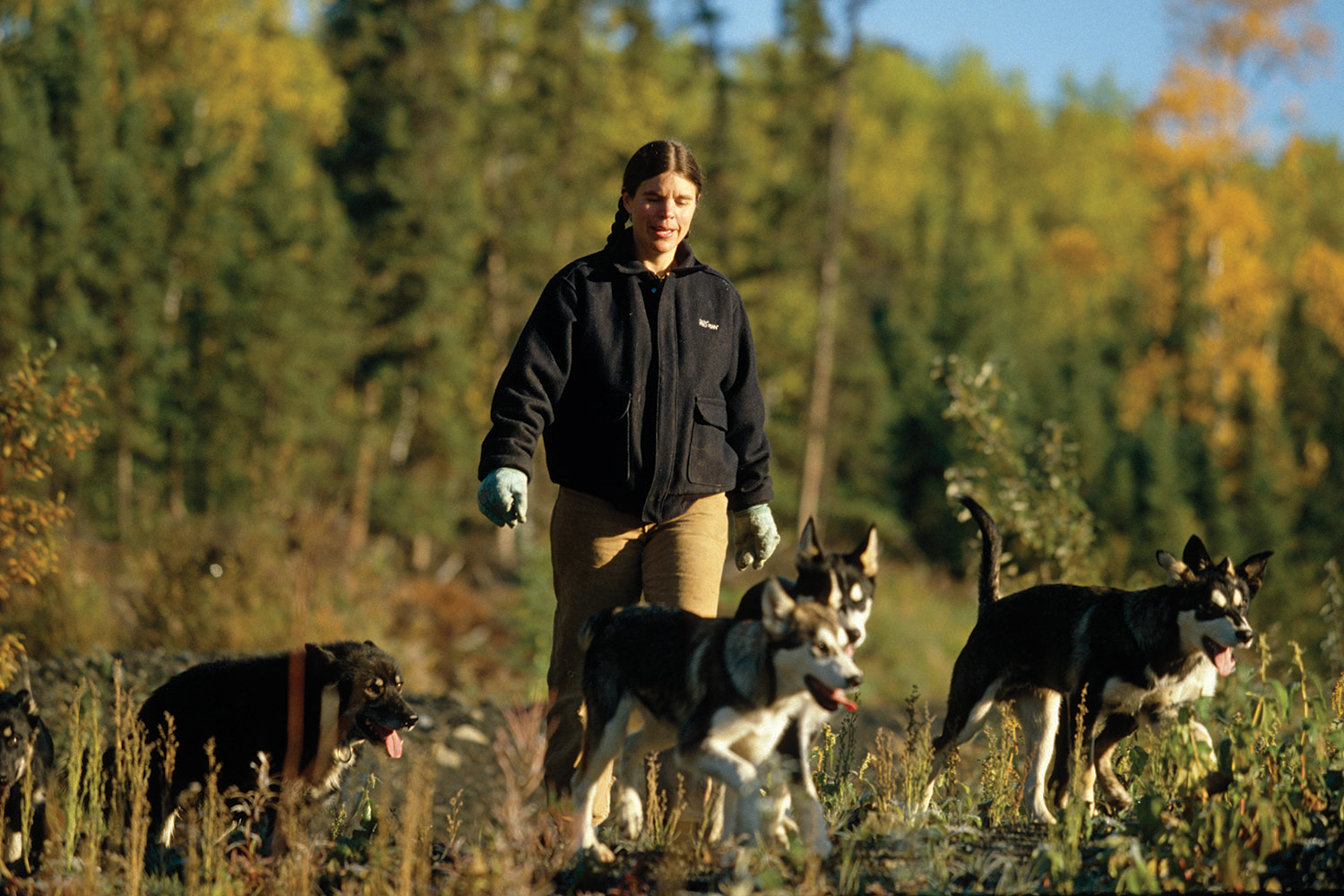
Butcher walks with her dogs at Manley Hot Springs, Alaska. Two years after Butcher’s death, former Alaska Gov. Sarah Palin proclaimed Susan Butcher Day on the first Saturday in March, which coincides with the start of the Iditarod. Photos by Jeff Schultz / AlaskaStock.com
A Devastating Diagnosis
In 2003, when her daughters were 8 and 3, Butcher started back on her rigorous training schedule with the hope of eventually competing again. But both she and Monson noticed that something was off. Butcher, one of the top endurance athletes in the world, was getting tired.
A blood screening revealed that Butcher had too many red blood cells, a condition known as polycythemia vera. As her marrow pumped out more and more red blood cells, her blood became unnaturally viscous, or thick, making her circulation as sluggish as she felt.
“Polycythemia vera is a disorder that causes the bone marrow to overproduce red blood cells,” says Farhad Ravandi, a medical oncologist at the University of Texas M. D. Anderson Cancer Center in Houston. Roughly 95 percent of polycythemia vera patients share the same mutation in a gene now known as janus kinase 2. “The gene has to do with marrow’s ability to respond to erythropoietin, or EPO, the hormone that tells it to make more blood cells,” says Ravandi. “In essence, the mutated gene turns off the body’s red-blood-cell-making ‘off switch.’ ”
Most patients with polycythemia vera live reasonably normal lives, other than taking low-dose aspirin daily and having blood draws—on average four to six times a year—to bring down red blood cell counts. However, about 3 to 10 percent of patients with polycythemia vera develop acute myeloid leukemia (AML). “We don’t really know why this happens, and we really have no way of predicting who this will happen to,” says Ravandi. “But it’s thought … that the mutation that underlies the polycythemia vera creates enough instability that other mutations occur.” Still, given the statistical improbability of developing AML and her track record of beating the odds, Butcher didn’t worry about the possible progression. “She was very focused on the girls, the dogs and racing,” says Monson.
In December 2005, two years after Butcher was diagnosed with polycythemia vera, blood work revealed that her white blood cell count was too low. After a bone marrow biopsy, Butcher’s doctors gave the couple the bad news. Her marrow was full of blasts, young white blood cells that were crowding out normal blood cells. Butcher had AML.
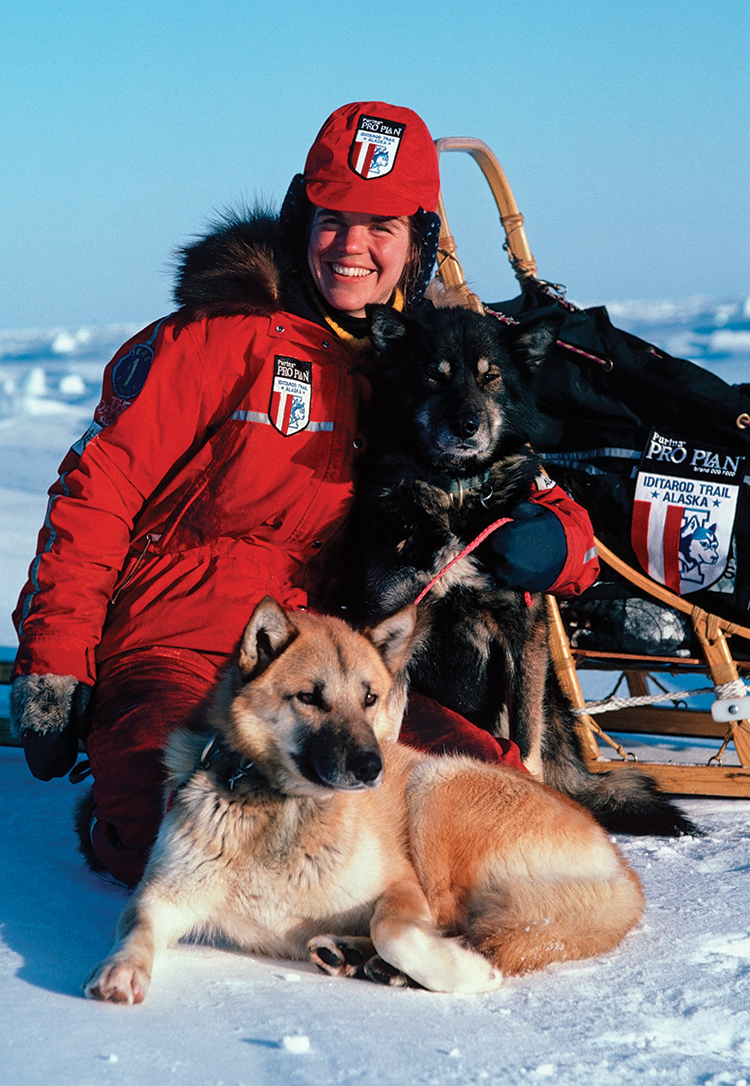
Butcher had a “trust-and-be-trusted relationship” with her dogs. Above she poses with lead dogs Granite and Sluggo. Photos by Jeff Schultz / AlaskaStock.com
Understanding AML
AML is the most common acute leukemia in adults. An estimated 20,830 Americans will be diagnosed with AML in 2015, and nearly 10,500 are expected to die of the disease this year. Most solid cancers are staged by how far they’ve spread from their original location, but because AML is blood-borne, the traditional staging system doesn’t apply. “It’s already in the blood, so it’s spread throughout the body,” says Richard Stone, a medical oncologist and director of the Adult Leukemia Program at the Dana-Farber Cancer Institute in Boston.
Instead, patients are usually categorized into one or more subgroups, based on the genetics and clinical features of the disease according to the World Health Organization’s classification system. The subgroups include those with known genetic abnormalities, those with previous exposure to chemotherapy or radiation, those whose cancer stems from previous marrow disorders, and those who can’t be otherwise categorized. In general, patients with a previous marrow disorder, like Butcher’s polycythemia vera, have a poorer prognosis.
Not much has changed in the way this type of leukemia is diagnosed and treated since the time of Butcher’s diagnosis, says Stone, who explains that blood work usually leads to a bone marrow biopsy to diagnose the disease. What has changed is how physicians understand the different subtypes of the disease. “Over the past decade, there’s been a lot of work on understanding the genetics of the disease. We know now there are at least 23 known mutations that underlie the development of AML,” says Stone.
Most AML patients have at least one mutation, while the average AML patient has five, Stone says. The hope is that someday doctors will be able to match these specific genetic abnormalities with highly targeted therapies, similar to how Gleevec (imatinib) has turned chronic myeloid leukemia from a lethal condition into a manageable chronic disease. For now, doctors are able to use some of the mutations in AML to predict how patients will respond to specific traditional chemotherapy regimens, as well as predict a patient’s prognosis.
More than 25 percent of AML patients survive three years or longer, but some subtypes have a better prognosis. Seventy percent of patients with an AML subtype called acute promyelocytic leukemia (APL), for example, will live at least three years. APL, which accounts for about 10 percent of AML cases, has a specific genetic mutation called a translocation, in which one chromosome is located on another chromosome. APL nearly always responds to a targeted treatment known as all-trans retinoic acid, a vitamin A derivative, given along with chemotherapy. The treatment has prolonged overall survival.
Butcher’s cancer didn’t have any known genetic AML mutations, says Janis Abkowitz, the oncologist at the University of Washington Medical Center in Seattle who treated her. “These days we have a much better understanding about how patients with certain genetic abnormalities will respond to chemotherapy,” says Abkowitz. “But that wouldn’t have changed Butcher’s treatment.”
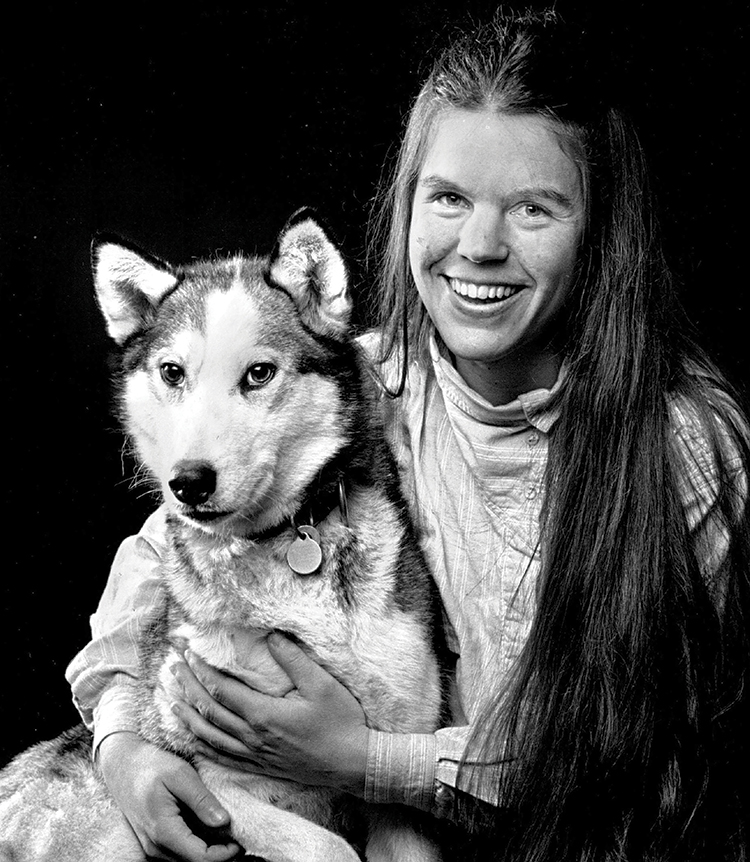
Susan Butcher. Photo by Betty Udesen / The Seattle Times
Troubling Complications
Today, just as when Butcher was treated, patients receive chemotherapy, usually with cytarabine and daunorubicin or cytarabine and idarubicin, in hopes of achieving a complete remission, a state where there are no detectable cancer cells in the body.
More than half of those patients who achieve complete remission will survive at least five years. Because Butcher had polycythemia vera before developing AML, her survival odds weren’t as good, and she needed a stem cell transplant to prevent her AML from recurring. “She was really young and healthy, and she went into remission right away, and everything was looking great,” says Abkowitz.
Butcher had the transplant in May 2006, about two months after finishing chemotherapy. “Because of the underlying instability [that comes with an initial poly-cythemia vera] diagnosis, these leukemias will almost always recur after remission,” says Abkowitz. “So she and David really wanted to go for a cure, which would have been possible with a stem cell transplant.”
In a stem cell transplant, all of the patient’s marrow is destroyed with chemotherapy and radiation. Then stem cells from a donor’s marrow are injected into the patient, giving the patient the donor’s healthy bone marrow. Unfortunately, in Butcher’s case, the newly transplanted white blood cells recognized her body as foreign and began to attack it, a process known as graft-versus-host disease (GVHD). “Graft-versus-host disease can take on many forms,” says Abkowitz. “Susan’s was very aggressive and came on really fast. She got the absolute worst kind.”
Despite treatment with heavy-duty immune suppressants, Butcher suffered first from bloating and skin rashes and then from fever, infections and multi-organ dysfunction. While nearly all patients who undergo a stem cell transplant will develop at least a mild, chronic form of GVHD, only a small percentage will have a severe, debilitating form that doesn’t respond to any treatment.
In the midst of the GVHD, and more than two months after the transplant, Butcher and Monson got even worse news: A follow-up bone marrow biopsy showed that Butcher’s marrow was full of white blood cell blasts. Butcher’s leukemia was back.
“We never talked about her not making it. It wouldn’t have felt right, to her or to me,” says Monson, who describes his wife’s underlying faith that hard work and tenacity would overcome obstacles and beat statistics. “It was the way we’d always conducted ourselves, we were a team, and we had never given up on anything.”
Butcher wouldn’t have been Butcher if she had quit believing she would make it. But as her organs continued failing one by one, she slipped into a coma. On Aug. 5, 2006, just eight months after her cancer diagnosis, Butcher died in her sleep.
“I think she was aware of her legacy, that she was an inspiration to so many people,” says Monson. “She lived more in 51 years than a lot of people do in 100.”
Cancer Today magazine is free to cancer patients, survivors and caregivers who live in the U.S. Subscribe here to receive four issues per year.

